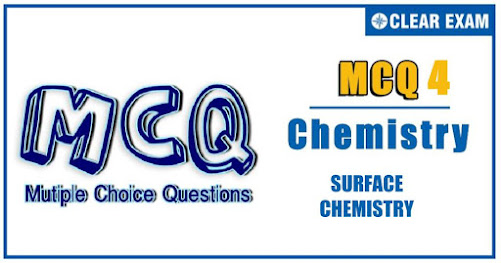IIT JEE exam which consists of JEE Main and JEE Advanced is one of the most important entrance exams for engineering aspirants. The exam is held for candidates who are aspiring to pursue a career in the field of engineering and technical studies.
Chemistry is important because everything you do is chemistry! Even your body is made of chemicals. Chemical reactions occur when you breathe, eat, or just sit there reading. All matter is made of chemicals, so the importance of chemistry is that it's the study of everything..
Q1. Statement 1: For the coagulation of sols carrying positive charge, PO4^(3-) ions are more efficient than SO4^(2-) or Cl^- ions
Statement 2: This follows Hardy-Schulze rule
Solution
(a). According to Hardy-Schulze rule coagulating power of an electrolyte is directly proportional to the fourth power of the valency of the ions causing coagulation
(a). According to Hardy-Schulze rule coagulating power of an electrolyte is directly proportional to the fourth power of the valency of the ions causing coagulation
Q2. Statement 1: A catalyst lowers the threshold energy level for reaction.
Statement 2: Catalyst combines with reactant to form an exothermic intermediate and provide another pathway to reaction.
Statement 2: Catalyst combines with reactant to form an exothermic intermediate and provide another pathway to reaction.
Solution
(c). Catalyst lowers energy of activation and threshold energy and provide another pathway to reaction.
(c). Catalyst lowers energy of activation and threshold energy and provide another pathway to reaction.
Q3.Statement 1: Aqueous gold colloidal solution is red in colour
Statement 2: The colour arises due to scattering of light by colloidal gold particles
Solution
(a). The colours is due to scattering. It depends upon the size of particles. Finest gold sol has red colour. As the size of the particle increases, it becomes purple, then blue, and finally golden yellow
(a). The colours is due to scattering. It depends upon the size of particles. Finest gold sol has red colour. As the size of the particle increases, it becomes purple, then blue, and finally golden yellow
Q4. Statement 1: In chemisorption, adsorption keeps on increasing with temperature
Statement 2: Heat keeps on providing more and more activation energy
Solution
(d). In chemisorptions, adsorption first increases and then decreases with change in temperature
(d). In chemisorptions, adsorption first increases and then decreases with change in temperature
Q5.Statement 1: Zeolites are water softner as well as catalyst.
Statement 2: The catalytic action of zeolites is based upon their shape selectivity.
Solution
(d). Both are different facts but true
(d). Both are different facts but true
Q6. Statement 1: A colloidal solution of Fe(OH)3 formed by peptization carries positive charge.
Statement 2: During formation of Fe(OH)3 solution, electrons are lost by the particles.
Solution
(c). During formation of Fe(OH)3sol,Fe^(3+) ions are adsorbed on the particles.
(c). During formation of Fe(OH)3sol,Fe^(3+) ions are adsorbed on the particles.
Q7.Statement 1: The activity of a catalyst depends upon the strength of physisorption .
Statement 2: The reactant must adsorb very strongly for the catalyst to be active.
Solution
(d). The activity of a catalyst depends upon the strength of chemisorption to a large extent. The reactant must absorb reasonably strongly for the catalyst to be active but must not adsorb so strongly that they are immobilized and other reactants are left with no space on catalyst surface for adsorption.
(d). The activity of a catalyst depends upon the strength of chemisorption to a large extent. The reactant must absorb reasonably strongly for the catalyst to be active but must not adsorb so strongly that they are immobilized and other reactants are left with no space on catalyst surface for adsorption.
Q8.Statement 1: Creaming from milk is known as phase inversion.
Statement 2: An agitation of milk brings in a change of D.P. into D.M. and vice-versa.
Solution
(c). Milk is o/w emulsion, cream is w/o emulsion. To convert a o/w emulsion into w/o emulsion is known as phase inversion which can be achieved by mechanical agitation.
(c). Milk is o/w emulsion, cream is w/o emulsion. To convert a o/w emulsion into w/o emulsion is known as phase inversion which can be achieved by mechanical agitation.
Q9.Statement 1: The micelle formation by a surfactant takes place at certain concentration at definite temperature.
Statement 2: The temperature above which a surfactant forms micelle is called Kraft point.
Solution
(d). Both are different facts but true.
(d). Both are different facts but true.
Q10. Statement 1: A needle can float on clear water but sinks when some detergent is added to it.
Statement 2: Detergent reduced the surface tension of water.
Statement 2: Detergent reduced the surface tension of water.
Solution
(c). Explanation is correct reason for statement.
(c). Explanation is correct reason for statement.





